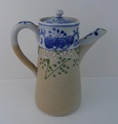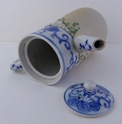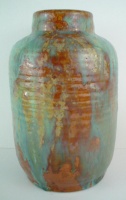Mystery Tea Pot
2 posters
Page 1 of 1
 Mystery Tea Pot
Mystery Tea Pot
This is a very small tea pot ( or coffee pot) with the upper section decorated in blue & white similar to Chinese ceramics. The lower section has a snakeskin patters with green and white enamel flowers. There is the odd iron rust spot which makes me think that it is Chinese. A previous owner has written on the base in pencil.
Has anyone seen something like this before?
Height: 13ccm






Has anyone seen something like this before?
Height: 13ccm







Marcusborra-
 Number of posts : 295
Number of posts : 295
Age : 78
Location : Bolton, Lancashire, England
Registration date : 2013-04-30
 Re: Mystery Tea Pot
Re: Mystery Tea Pot
It looks Japanese and fairly new. Someone's signed it Canterbury 19th 98' - maybe a birthday or anniversary date. I suspect they bought it new in 1998
_________________
Carrot cake is just fake cake
 Re: Mystery Tea Pot
Re: Mystery Tea Pot
Thanks Naomi, you have pointed me in the right direction. On a well known auction which will be nameless there is a small globular teapot with the identical decoration.
" ANTIQUE JAPANESE MEIJI BANKO SALT GLAZED TEA POT"
Don't know how they identified this.
" ANTIQUE JAPANESE MEIJI BANKO SALT GLAZED TEA POT"
Don't know how they identified this.


Marcusborra-
 Number of posts : 295
Number of posts : 295
Age : 78
Location : Bolton, Lancashire, England
Registration date : 2013-04-30
 Re: Mystery Tea Pot
Re: Mystery Tea Pot
This seems to be an early item made for export when stocks of white clay were still available.
Banko is a group of rustic Japanese wares made during the Meiji Period in the nineteenth and twentieth centuries. Some pieces are made of mosaics of coloured clay, some are fanciful teapots.
The Banko mark, a small incised oval with Japanese characters, was often used on the pottery.
Bankoyaki was established in the mid 1700’s in Obuse in Mie-pref. by a powerful merchant, Nunami Rouzan. His strong interest in tea ware lead to the production of original designs with foreign influences (such as arabesque) and became very popular in Edo.
After the death of Rouzan, production ceased until the 1800’s when two talented young brothers Mori Yusetsu and Senchu set up a kiln and started reproducing old Banko ware. By this time people’s preferences were taking a turn towards delicate and ornate pieces so the Mori brothers made use of new techniques such as wood molding and the use of vitreous enamel to paint moriage (raised) motifs etc.
In 1870 Yamanaka Chuzaemon established a kiln in Yokkaichi-city where great numbers of delicate, thin bodied teapots made of white clay were produced for export. When this white clay became scarce, the remaining clay, rich in iron was used to make teapots on the potter’s wheel. This was how shidei teapots came to be made in Yokkaichi-city, starting a tradition that continues to this day.
Banko is a group of rustic Japanese wares made during the Meiji Period in the nineteenth and twentieth centuries. Some pieces are made of mosaics of coloured clay, some are fanciful teapots.
The Banko mark, a small incised oval with Japanese characters, was often used on the pottery.
Bankoyaki was established in the mid 1700’s in Obuse in Mie-pref. by a powerful merchant, Nunami Rouzan. His strong interest in tea ware lead to the production of original designs with foreign influences (such as arabesque) and became very popular in Edo.
After the death of Rouzan, production ceased until the 1800’s when two talented young brothers Mori Yusetsu and Senchu set up a kiln and started reproducing old Banko ware. By this time people’s preferences were taking a turn towards delicate and ornate pieces so the Mori brothers made use of new techniques such as wood molding and the use of vitreous enamel to paint moriage (raised) motifs etc.
In 1870 Yamanaka Chuzaemon established a kiln in Yokkaichi-city where great numbers of delicate, thin bodied teapots made of white clay were produced for export. When this white clay became scarce, the remaining clay, rich in iron was used to make teapots on the potter’s wheel. This was how shidei teapots came to be made in Yokkaichi-city, starting a tradition that continues to this day.

Marcusborra-
 Number of posts : 295
Number of posts : 295
Age : 78
Location : Bolton, Lancashire, England
Registration date : 2013-04-30
Page 1 of 1
Permissions in this forum:
You cannot reply to topics in this forum
